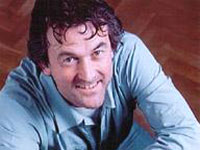2005 European Championships - Composers talk - Johan de Meij
11-May-2005John James was on hand to hear the composer of Extreme Make Over give his thoughts and fancies on the inspiration behind his work - from Tchaikovsky to Frank Zappa.
 This session was undertaken in the hour immediately preceding the Championship set test piece contest and was conducted in interview style by the composer himself.
This session was undertaken in the hour immediately preceding the Championship set test piece contest and was conducted in interview style by the composer himself.
Orchestral and rock music examples were used to supplement the talk, projected through the room sound system and these helped crystallize the composer's thoughts whilst you felt that the composer could have comfortably continued describing the piece for a good while after the allotted time was complete but he did have a few tussles with the computer graphics during this session.
This may have been his first but hopefully it is not last Championship Section composition for brass band. He explained that he had a working knowledge of the brass family currently playing trombone but formally, more on many keyed instruments with the exception of soprano cornet.
One felt that his opening remark was one of the most important he was to deliver throughout the session: "I would rather write music that tests musicality," he said, "rather than a test piece that primarily acts as an exam piece. I hope I have done this with ‘Extreme Make-Over'."
He relayed his feelings in being asked to compose this test piece that he acknowledged had some very clear traditional brass band moments but also gave him the opportunity to stamp his own mark in music.
"I have avoided the fast-slow-solo passage style on purpose," he said, "However the marimba solo was written purposely to place the percussion section as integral to the ensemble."
He expanded explaining that this technically and musically difficult work of 16 minutes required everybody to share and take part in its development. He had tried to make a good test despite his view that he didn't particularly like composing pure test pieces as such.
Playing the original string quartet as a reference he described the first makeover being noted at bar 38 as the cornets ‘sneak in' - a musical line actually and quite purposefully well hidden.
As he worked on the piece, particularly at bar 51, he added an extra note into the musical structure and this brought with it a tonal structure more 20th Century in character. Through bars 72 to 154 he described his use of musical structure and form particularly reflecting his appreciation of vocal arrangements. The timp solo that that follows, he explained, was a reflection of the canonic style of the final melody.
It was now that he incorporated several quotes from both the '4th' and '6th Symphonies' all bound together with Salvationist influences. At bar 162 the bass line and further makeover was a quote from the 6th Symphony specifically placed to give the music a Russian feel and the ensuing influence of ‘Romeo and Juliet' in the trombone line continued this progression.
The accented quavers at bar 278 in both brass and percussion once more saw ‘Romeo and Juliet' being introduced to add atmosphere. As the music continues to develop he continued by adding further quotes without spoiling the flow of the music until the timpani was directly called on, much as the use Tchaikovsky made of this instrument in his orchestration.
The use of bottles took the music closer to the gamelan style first explored from bar 51. Here he was keen to explore a different world, but throughout he was keen that the music responded to the opening three notes of the work.
As the brass joined this section the musical world of Steve Reich can be uncovered in the scoring and the end of this makeover can quite clearly see influence of Stravinsky. The final musical example used to illustrate the scoring was that of Frank Zappa.
At bar 496 the instruction to percussion "follow the melodic line by using various non-pitched percussion" did not purposefully follow the musical principles adopted by the rock musician but was a co-incidental pattern incorporated in the natural progression of the makeover.
The session was reaching its conclusion as the composer acknowledged his desire to draw the music to a triumphal conclusion and naturally the quote from the 1812. His final example from the score pointed toward bar 165 when the timpani finally and importantly restated the theme.
This was a most interesting insight into the thought processes that went into the construction of this score which the composer hoped would find its way into the repertoire not just the test piece in contest arena.
A full room left this interesting personal overview and immediately took their seats to discover that this was a most complex piece with many more influences and more makeovers than described in this short talk.
No wonder one felt that the composer could have comfortably continued describing the piece for a good while after the session concluded.
John James















